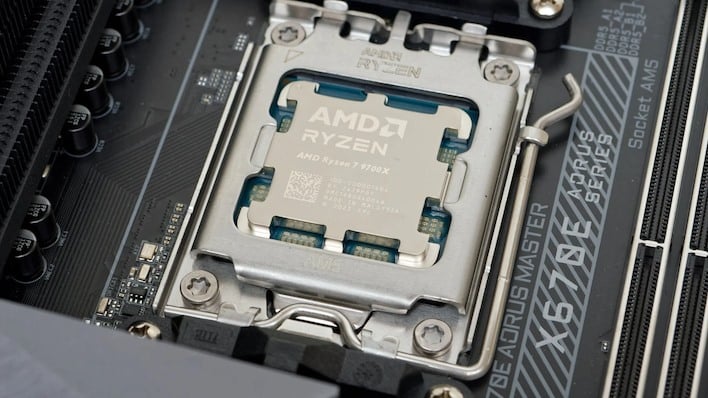
AMD and its partners have released a barrage of motherboards today based on the latest Socket AM5 chipsets. That’s the X870, as well as the dual-chip X870E version, if you haven’t been staying on top of things. Along with the fancy new mainboards, AMD has also released new AGESA firmware to its partners that promises to accelerate Ryzen 9000 CPUs in a couple of different ways.
First up, the firmware. There are two updates launching with AMD AGESA PI 1.2.0.2. The first, we’ve already written about a bit. AMD is adding an official 105W mode to the Ryzen 5 9600X and Ryzen 7 9700X. These CPUs shipped with 65W TDP ratings, and many found that the Ryzen 7 9700X in particular could end up being power limited at 65W in multi-core workloads. AMD says that using the new fully-warrantied 105W TDP can earn the Ryzen 7 9700X an extra 10% performance. Of course, enthusiasts using PBO won’t see any difference, but keep in mind that Precision Boost Overdrive is overclocking and does void your warranty.
The other notable performance-boosting update coming with AGESA PI 1.2.0.2 is another thing we’ve written about before. It’s the optimization improving core-to-core latency. In short, some testers found that dual-CCD Ryzen 9000 processors show unusually high core-to-core latency compared to other chips. It was apparently a bug of some kind, because AMD has fixed it. It doesn’t make much difference in performance, though, and AMD says that this is because the method used to expose it is actually itself a corner case and doesn’t reflect real-world use.
AMD also notes that the Windows Update KB5041587 branch prediction optimizations are “no longer optional,” meaning that Windows 11 is going to install this update for you whether you like it or not. That’s a good thing, though. AMD says that this update will improve performance for all Ryzen users. From our understanding, the issue was down to an exploit mitigation for Intel processors being applied to AMD processors when it was not needed. If you have exploit protections disabled, you won’t notice the difference, as we didn’t in our testing.
As for the new X870E and X870 chipsets, they are strictly for high-end enthusiast systems. AMD is introducing a new lineup of 800-series chipsets for Zen 5, but X870 is clearly intended to provide a high-end, halo option for power users and enthusiasts who demand absolutely massive amounts of connectivity. Check out the table above for comparisons, and check out the flowchart below to see just how much I/O you can have on Socket AM5.
The X870 chipset diagram looks essentially like this, except that instead of a second X870E chipset, those four PCIe 4.0 lanes go to an M.2 socket. Otherwise, the connectivity is all the same. It’s difficult to imagine a typical use case where the second X870 chipset on the “E” boards is really necessary, but there are plenty of atypical use-cases out there.
This slide shows the other two 800 series chipsets that are on the way. The B850 looks an awful lot like the extant B650 chipset, while the B840 strongly resembles the entry-level A620 chipset. It’s likely that AMD is offering rebadges to give motherboard vendors an excuse to launch new boards. Don’t be fooled, though. AMD assures us that the above firmware updates are coming to currently-available Socket AM5 motherboards, and unless you’re in dire need of Wi-Fi 7, PCIe 5.0 graphics connectivity, or USB 4.0, there’s really not much reason to upgrade if you’re already on AM5.
We’ve got a couple of the new X870 motherboards coming into the lab now, and we’re hard at work putting them through their paces. We’ll have a comparison of the boards for you before too much longer, so sit tight.





